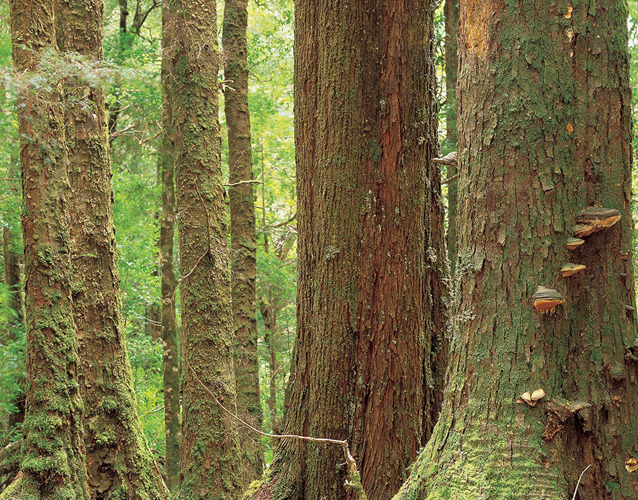Australia’s impending carbon pricing scheme provides a framework for possible credits for Tasmanian forest managers, but they don’t seem to want to know about it. [23 August 2011 | Peter Boyer]
There’s a curious thing about the “Tasmanian forests intergovernmental agreement” signed by Julia Gillard and Lara Giddings on August 7.
The agreement, with the express aim of making Tasmanian forestry more sustainable and building economic diversity and community resilience, is all about managing big trees, and big trees are peerless carbon stores.
This seems to fit nicely with the Gillard government’s recently-announced Carbon Farming Initiative, which provides for credits to be paid to landholders who help reduce carbon in the atmosphere by sequestering and storing it on their land. Among the activities supported by the CFI are tree-planting and protection of native forests.
Acknowledging this potential, the Tasmanian government has called for tenders, with a deadline of next Monday, to investigate “how our forests store and release carbon and whether there are opportunities to derive economic benefits from storing carbon in our trees.”
The opportunities for Tasmania would seem to be huge in the context of Australia’s difficult path to turn around its carbon emissions by 2020.
A new study of potential carbon credits from reduced forest harvesting by ANU academic lawyer Andrew Macintosh finds that emissions saved by stopping native forest logging now amounts to nearly half the savings needed to reach Australia’s 2020 target, worth hundreds of millions of dollars in carbon credits.
Even emissions avoided by keeping native forest harvesting at 2010 levels would yield Australia a saving of 12 million tonnes of greenhouse gases a year, or about 14 per cent of the 2020 target.
Macintosh’s study indicates a high potential for long-term financial returns for Tasmanian forestry if it reduces harvesting rates to focus on managing trees for carbon.
Yet in all its 5000-odd words this month’s intergovernmental agreement makes only a single passing reference to carbon, noting in Clause 47 that “the governments will continue to discuss issues around the treatment of any potential carbon offset opportunities that may arise for Tasmania”. Its mention of sustainability and resilience is no more than a motherhood statement, with no pointers as to how these concepts might apply to a future forest management regime.
If you see carbon storage as integral to a sustainable future for Tasmanian forests, you might think that the omission was accidental, or at worst a way to ensure that a skittish forest industry, always wary of conservationist subterfuge, stays on side while the agreement is bedded down.
But there’s another reason for this disconnect. It involves the labyrinths of international diplomacy, going all the way back to the Kyoto climate protocol, and the controlled, duplicitous, schizophrenic world of the bureaucrats and politicians who devise these international contrivances.
In 1997 at Kyoto, Australia stood out from the international community by arguing that its reduced rates of land clearing a few years earlier should count as credits for post-1990 emission reduction. The “Australia clause”, as it became known, enabled this country to claim big cuts in emissions early this century when in fact emissions were rising steadily.
Though it allows credits for “avoided deforestation” in developing countries, Kyoto doesn’t cover forest harvesting in developed countries, choosing to assume that there’s no net loss of carbon from these countries’ forests. As a result, successive Australian governments have excluded forest harvesting emissions from greenhouse accounts.
Instead we have seen the limited development of voluntary carbon markets, under an international “Improved Forest Management” umbrella program, in which finance is available to private individuals and businesses who conserve carbon stocks by protecting trees on their land.
Such markets may have a more secure footing after 2012, when the Kyoto period ends. A new international agreement will likely allow credits to developed countries for sequestering and storing carbon in trees, so long as such schemes are properly set up to actively manage for carbon, adding to the abatement effort and not simply “business as usual”.
But for more than a decade the Australian forest industry and its political masters have focused on tree harvesting and the people employed in it. Taking their cue from the Kyoto-based greenhouse accounting system, they seem to be saying that carbon pricing has nothing to do with them.
You can see the disconnect in the way both state and federal governments operate. We have our forest ministers, Joe Ludwig in Canberra and Bryan Green in Hobart, operating in a world completely separate from that of climate ministers Greg Combet and Cassy O’Connor.
Given such arrangements, it wasn’t too hard for Gillard and Giddings to treat the forest deal solely in terms of harvesting and reserved lands, skimming over the potentially more lucrative option of active management for carbon. It’s as if “what we don’t talk about doesn’t exist”.
It can’t continue. Eventually the separate parties must come together. The pressure on Australian and Tasmanian governments to produce real progress towards their respective carbon targets — targets which will only get tougher over time — is steadily increasing.
The growing international support for a mechanism to accommodate forest carbon management within developed countries should be a clear sign to Tasmania’s forest managers that sustaining high levels of tree carbon will be a big part of their future.
It seems the penny has yet to drop. When that finally happens, the industry might at last discover the peace and stability that for so long have eluded it.

